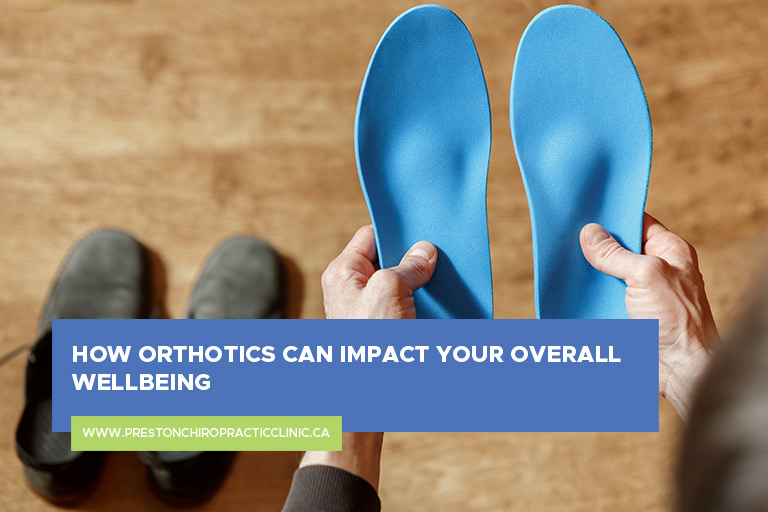 16 Dec 2023
16 Dec 2023
How Orthotics Can Impact Your Overall Wellbeing
Since their invention thousands of years ago, orthotics have allowed countless people to improve their quality of life. People wearing orthotics are more common than you may realize. According to research from the World Health Organization, somewhere between 35 and 40 million adults wear orthotics.
That said, orthotics aren’t just about your feet. They can actually have a positive impact on your entire body. Keep reading to learn more about how orthotics can impact your overall well-being.
What Are Orthotics?
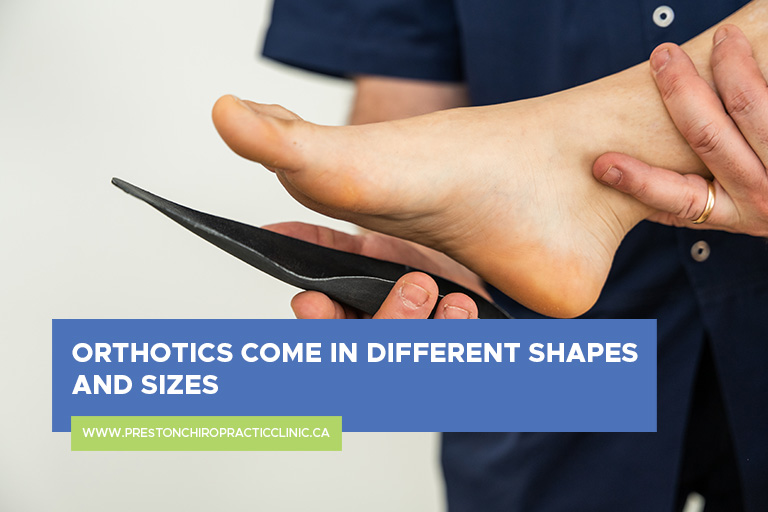 Orthotics refer to specialized devices designed to support or correct the musculoskeletal system, particularly focusing on the feet and lower limbs. These devices serve to address issues related to foot alignment and structure.
Orthotics refer to specialized devices designed to support or correct the musculoskeletal system, particularly focusing on the feet and lower limbs. These devices serve to address issues related to foot alignment and structure.
Orthotics are employed to alleviate various conditions such as foot pain, flat feet, overpronation, and sports-related injuries. It’s crucial for orthotics to be prescribed and fitted by healthcare experts to ensure their effectiveness in addressing specific issues and promoting overall musculoskeletal health.
Common Types of Orthotics
Insoles or Shoe Inserts
These are widely used and can be either over-the-counter or custom-made. They provide additional support, cushioning, and alignment for the feet and are often used for general comfort or to address specific foot conditions.
Arch Supports
Designed to offer extra support to the arch of the foot, arch supports are beneficial for individuals with conditions such as flat feet or fallen arches. They help maintain proper foot alignment.
Heel Cups or Inserts
These orthotic devices focus on the heel, providing additional cushioning and support. They are commonly used to alleviate discomfort associated with conditions like plantar fasciitis.
Ankle Braces
Ankle braces are utilized to support and stabilize the ankle. They are often recommended for individuals recovering from ankle injuries or those with chronic instability.
Custom Orthotics
Prescribed by healthcare professionals, custom orthotics are tailor-made devices crafted to suit an individual’s specific foot structure and address unique concerns. These are often used for more severe or specific conditions.
Conditions That Often Require Orthotics
Orthotics can be used to treat a wide variety of conditions. Below are some of the most common:
Plantar Fasciitis
This condition involves inflammation of the plantar fascia, a band of tissue connecting the heel bone to the toes. Orthotics for plantar fasciitis, particularly heel cups or inserts, can provide support and alleviate pain.
Flat Feet
Flat feet happen when the arches of the feet are flattened. Arch supports or custom orthotics can help provide the necessary support and alignment for flat-footed people.
Overpronation or Supination
Overpronation is an excessive inward rolling of the foot, while supination is an outward rolling. Both conditions can lead to biomechanical issues, and orthotics are often prescribed to correct and balance foot movement.
Bunions
A bunion is a bony bump that forms at the base of the big toe. Orthotics, especially those designed to relieve pressure on the affected area, can help manage discomfort and prevent the worsening of the condition.
Achilles Tendinitis
This condition involves inflammation of the Achilles tendon, commonly caused by overuse or improper footwear. Orthotics can provide support and reduce strain on the tendon during movement.
Shin Splints
Orthotics may be recommended for individuals experiencing pain along the shinbone, known as shin splints. They can help correct foot mechanics and reduce stress on the shin.
Knee Pain
Poor foot alignment can contribute to knee pain. Orthotics that address issues such as overpronation or flat feet may help improve biomechanics and alleviate knee discomfort.
Sports Injuries
Athletes often use orthotics to prevent or manage injuries related to the feet and lower limbs. Customized orthotics can offer support and enhance performance while reducing the risk of injuries.
Diabetic Foot Conditions
People with diabetes may experience foot problems, such as neuropathy or ulcers. Orthotics can help offload pressure points, reduce friction, and provide support to prevent complications.
How Orthotics Can Contribute to Your Overall Wellbeing
 As mentioned earlier, orthotics aren’t just about relieving your feet. Orthotics can contribute significantly to overall well-being by addressing and alleviating various foot and lower limb conditions, which, in turn, can positively affect the entire musculoskeletal system.
As mentioned earlier, orthotics aren’t just about relieving your feet. Orthotics can contribute significantly to overall well-being by addressing and alleviating various foot and lower limb conditions, which, in turn, can positively affect the entire musculoskeletal system.
Pain Relief
Orthotics are often prescribed to alleviate pain associated with conditions such as plantar fasciitis, flat feet, or bunions. By providing support and proper alignment, orthotics can reduce strain on the feet and lower limbs, decreasing pain and discomfort.
Improved Biomechanics
By improving the alignment and movement of the feet, orthotics contribute to better overall biomechanics, reducing the risk of injuries and enhancing functional movement.
Prevention of Further Issues
Orthotics can prevent the progression of certain foot conditions. For example, they may help prevent the worsening of bunions or provide support to individuals with flat feet, minimizing the risk of related complications.
Enhanced Mobility
Orthotics can improve stability and support, allowing for better balance and enhanced mobility. This is particularly beneficial for older adults or those with chronic conditions.
Reduced Impact on Joints
Proper foot alignment provided by orthotics can help distribute pressure more evenly across the feet and lower limbs. This subsequently reduces the impact on joints, including the knees, hips, and lower back, contributing to joint health.
Management of Chronic Conditions
Orthotics can help prevent foot ulcers, reduce pressure points, and support individuals with neuropathy, contributing to overall diabetic foot care.
Invest in The Best Orthotics in Cambridge
Being prescribed orthotics can help you enjoy life to the fullest. At Preston Chiropractic and Physiotherapy, we specialize in high-quality custom orthotics. We use state-of-the-art technology to ensure that your orthotics are the perfect fit. Contact us at (519) 653-7139 today to learn more.
BY: PrestonchroAdmin
Blog
COMMENTS: No Comments
 15 Nov 2023
15 Nov 2023
How Chiropractic Care Can Enhance Athletic Performance
Athletes at all levels are constantly looking for ways to improve their performance. While working with trainers, following specific diets, and trying new workout routines are all common ways for athletes to try to give themselves an edge, chiropractic care is another option that many may have yet to explore.
While some may think that chiropractors are only for helping people recover from injuries or relieve stiff joints, the reality is that chiropractic care can also be very beneficial for athletes.
Keep reading to learn more about chiropractic care and how it can be a great tool to enhance athletic performance.
What Is Chiropractic Care?
 Oftentimes, when people hear the word chiropractic, they instantly envision someone getting their neck and/or back cracked. However, that isn’t all that chiropractic care has to offer.
Oftentimes, when people hear the word chiropractic, they instantly envision someone getting their neck and/or back cracked. However, that isn’t all that chiropractic care has to offer.
Chiropractic care is a holistic approach to health that focuses on the musculoskeletal system, particularly the spine. It emphasizes the body’s ability to heal itself without the need for medication or surgery. Chiropractors use hands-on spinal manipulation and other alternative treatments to alleviate pain, improve mobility, and promote overall well-being.
How Chiropractic Care Can Enhance Athletic Performance
 Help Manage Pain
Help Manage Pain
Chiropractic care addresses misalignments in the spine and focuses on enhancing the body’s overall function. This can help alleviate the acute and chronic pain that many athletes experience during training or competition.
Chiropractors can also provide personalized rehabilitation exercises and guidance that can help reduce pain and swelling. This proactive approach not only helps manage existing pain but also aids in preventing future issues by improving overall body mechanics and alignment.
Prevent Injuries
Not only can injuries be detrimental to an athlete’s current performance, but they can also cause issues throughout a person’s entire career. Fortunately, regular chiropractic care can help athletes avoid injuries. Thanks to proper spinal alignment, athletes can experience improved muscle coordination and overall biomechanical efficiency, reducing the risk of strains, sprains, and other sports-related injuries. Chiropractic care for sports energies is one of the benefits that will instantly draw athletes to this form of care.
Improve Joint Function
Chiropractic care offers a unique approach to enhancing joint function in athletes. With their focus on the spinal column and its impact on the nervous system, chiropractors can identify and address any misalignments that may be hindering optimal joint performance. They can restore proper alignment through targeted adjustments, reducing tension and improving range of motion.
Additionally, chiropractic care can help improve joint proprioception in athletes. Proprioception is the body’s awareness of its position in space, which is crucial for balance and coordination during physical activities. Chiropractors can work with athletes to enhance their proprioceptive abilities through specific adjustments and exercises designed to optimize joint positioning and muscle function.
Improved proprioception not only enhances an athlete’s agility and responsiveness but also supports injury prevention by promoting better body control during dynamic movements.
Lessen Recovery Time
Any athlete who has ever been injured knows that the recovery process can be long and grueling. Chiropractic care can aid in improving flexibility and range of motion, which are essential for athletes looking to bounce back from injuries quickly.
Chiropractors’ ability to target specific areas of the body that may be restricting movement or causing pain can help athletes regain mobility and agility more efficiently.
Reduce Stress
Chiropractic care offers athletes a multifaceted approach to reducing stress by targeting physical and physiological aspects of their well-being.
Chiropractic care’s emphasis on pain management is crucial in alleviating chronic discomfort, a significant source of stress for athletes. In addition, the holistic approach of chiropractors, which may include lifestyle and nutritional guidance, contributes to a comprehensive strategy for stress reduction.
Chiropractic care fosters a less stressed and more resilient athletic experience. Individual responses may vary, so athletes should always consult with their chiropractor.
Improve Respiratory Function
Respiratory function probably isn’t the first thing that comes to most people’s minds when they think of athletes and chiropractic care. However, athletes who receive regular chiropractic care may see an improvement in their breathing.
The spine is directly linked to the nervous system, which controls the functioning of the lungs and diaphragm. Athletes who use chiropractic can experience improved nerve flow to these vital respiratory muscles through chiropractic adjustments, leading to enhanced breathing capacity and efficiency during physical activity.
Chiropractic treatment can also help reduce tension in the muscles surrounding the chest and ribcage, allowing for fuller, deeper breaths. This is particularly beneficial for athletes who engage in high-intensity workouts or endurance sports where optimal respiratory function is crucial for peak performance. Chiropractic care allows athletes to maximize their lung capacity and oxygen intake by addressing spinal misalignments and muscle tension.
Improved Flexibility
Flexibility is often overlooked in favor of strength, but being flexible can benefit many athletes. Flexibility contributes to better posture and alignment. This leads to enhanced balance and stability. Due to its ability to help athletes increase their range of motion, chiropractic care can also help athletes become more flexible.
A high level of flexibility can be especially important in sports such as gymnastics, swimming/diving, skating, and surfing.
Work With a Chiropractor in Cambridge
If you’re an athlete who is looking for something new to add to your training regimen, chiropractic care is something you should definitely consider. Not only does chiropractic care offer many benefits, but it’s also a great option for people who prefer taking a holistic approach to their athletic journey.
At Preston Chiropractic and Physiotherapy, we specialize in working with athletes. In addition to our chiropractic care, we also offer other services that can help enhance athletic performance. Contact us today at (519) 653-7139 to take the first step towards taking your athletic performance to new heights.
BY: PrestonchroAdmin
Blog
COMMENTS: No Comments
 17 Oct 2023
17 Oct 2023
Getting Back in the Game With Physiotherapy
In sports and physical activity, injuries are often an unfortunate reality. Whether you’re a professional athlete or a weekend warrior, the risk of sustaining an injury is always present. When these injuries occur, the road to recovery can be long and challenging. This is where physiotherapy for sports injuries plays a crucial role in getting individuals back in the game. Physiotherapy promotes healing and rehabilitation in various ways, making it an essential component of sports injuries treatment.
How Physical Therapy Promotes Healing
Physiotherapy generally includes specific workouts, stretching routines, and massages. Your therapist devises a tailored physical therapy program considering your injury, current fitness level, and objectives to prevent injuries.
During your therapy sessions, they lead you through a series of exercises while also prescribing exercises for you to perform at home. By diligently engaging in these exercises and stretches, you can safely regain mobility following an injury and significantly enhance your ability to prevent future sports injuries.
Here’s how physiotherapy helps in sports injury:
- Heal Soft Tissues
In sports, it’s a fairly regular occurrence to face injuries concerning the body’s soft tissues, like muscle tension and ligament stretching. The field of physiotherapy contributes to the healing of these bodily tissues by using techniques that reduce swelling, improve blood flow, and promote the restoration of tissues.
- Increase Joint Mobility
Many sports injuries can lead to decreased joint mobility. Physiotherapy focuses on restoring this mobility by using specific exercises and stretches. These movements are designed to increase joint flexibility, reduce stiffness, and prevent long-term mobility issues.
- Improves Flexibility
Flexibility is vital for preventing injuries and enhancing athletic performance. Physiotherapists work with athletes to enhance their flexibility using various stretching routines and strategies. This increased flexibility helps in the recovery and prevention of sports injuries.
- Rebuild Muscle Strength
Muscle weakness is a common consequence of sports injuries, as athletes often lose strength during the recovery process. Physiotherapy emphasizes rebuilding muscle strength through targeted exercises and resistance training. These exercises not only help regain strength but also improve overall muscle function.
- Restore Range Of Motion
After an injury, it’s common for athletes to experience a reduction in their range of motion. Physiotherapy helps restore the normal range of motion through guided exercises and hands-on techniques. This ensures that athletes can return to their sport with the same level of mobility and agility as before the injury.
Common Sports Injuries Physiotherapy Can Help
 You might consider initiating a physical therapy program in cases of injury. Examples of sports injuries are as follows:
You might consider initiating a physical therapy program in cases of injury. Examples of sports injuries are as follows:
- Arthritis
Athletes, especially as they age, often contend with degenerative joint issues like osteoarthritis. Physiotherapy can alleviate the associated pain and stiffness using exercises, joint mobilization, and pain relief techniques.
- Bursitis
Bursitis is an inflammation of tiny, fluid-filled sacs that act as a buffer and prevent friction between bones, tendons, and muscles. Physiotherapy can help to lessen discomfort while reducing inflammation and provide exercises to strengthen the injured area.
- Dislocation
Joint dislocations are uncomfortable and may harm soft tissues. After a dislocation, physiotherapy is crucial to the recovery process since it focuses on regaining joint stability, mobility, and strength.
- Fracture
Proper rehabilitation is vital for fractures, such as broken bones, to ensure optimal healing and minimize potential complications. Physiotherapists tailor programs to rebuild strength, mobility, and function around the fracture site.
- Tendonitis
Overuse injuries like tendonitis, which involves tendon inflammation, are frequent among athletes. Physiotherapy tackles tendonitis by incorporating rest, exercises, and modalities like ultrasound and ice therapy to reduce inflammation.
- Shoulder Instability
Athletes, especially in sports like baseball and swimming, often experience shoulder instability due to repetitive overhead movements. Physiotherapy concentrates on strengthening shoulder muscles and stabilizing the joint to prevent further issues.
- Sprain or Strain
Sprains and strains can affect different parts of the body. Physiotherapy employs a structured approach to rehabilitate these injuries, employing techniques like RICE (rest, ice, compression, and elevation) and progressive exercises to aid in recovery.
- Rotator Cuff Tear
Rotator cuff tears can be particularly challenging for athletes, affecting shoulder mobility and strength. Physiotherapy is a crucial element in the treatment process, aiming to fully restore shoulder function and strength.
Sports Injury Rehabilitation and the Role of Physiotherapy
 Physiotherapy plays an essential role in the recuperation of athletes following a wide range of injuries. Let’s delve into the specific ways physiotherapy aids in injury rehabilitation:
Physiotherapy plays an essential role in the recuperation of athletes following a wide range of injuries. Let’s delve into the specific ways physiotherapy aids in injury rehabilitation:
- Customized Treatment Plans
Physiotherapists develop individualized treatment plans tailored to the athlete’s specific injury, needs, and goals. These plans take into account the severity of the injury, the athlete’s level of fitness, and the sport they’re involved in.
- Pain Management
Pain management is an essential component of sports injury rehabilitation. Physiotherapists use many techniques, such as manual therapy, electrotherapy, and exercises, to relieve pain and discomfort, allowing athletes to focus on their recovery.
- Restoring Functionality
The primary goal of physiotherapy is to restore functionality to the injured area. By using a combination of exercises, stretches, and hands-on techniques, physiotherapists aid athletes in recovering strength, flexibility, and stability.
- Injury Prevention
In addition to healing existing injuries, physiotherapists work on preventing future injuries. They assess an athlete’s biomechanics, identify weaknesses or imbalances, and develop strategies to minimize the risk of further injuries.
- Facilitating Recovery
Physiotherapy guides athletes through the appropriate stages of rehabilitation, facilitating a swifter and more effective recovery. This helps them safely return to their sport sooner.
- Enhancing Athletic Performance
Physiotherapy isn’t solely about recovery; it also encompasses enhancing an athlete’s overall performance. It addresses underlying issues, corrects muscle imbalances, and optimizes physical conditioning to unlock an athlete’s maximum performance potential.
- Psychological Support
Injuries can pose significant mental challenges for athletes. Physiotherapists often provide psychological support to help athletes cope with the emotional aspects of injury, such as anxiety, frustration, and the fear of re-injury.
Physiotherapy is an indispensable component of sports injury rehabilitation, tending to the physical, psychological, and performance-related dimensions of recovery. It empowers athletes not only to recover from their injuries but also to return to the game in a strengthened state, better equipped to prevent future injuries. If you’re looking to get back in the game after a sports injury, Cambridge Physiotherapy is an invaluable partner on the path to recovery and performance improvement. Contact Preston Chiropractic & Physiotherapy Clinic at (519) 653-7139 to schedule a consultation!
BY: PrestonchroAdmin
Blog
COMMENTS: No Comments
 25 Sep 2023
25 Sep 2023
Boosting Athlete Potential With Chiropractic Care
Sports chiropractic care is a special plan for athletes designed to help them perform their best, stay healthy, and prevent future injuries. If you’re looking to enhance your performance in your chosen sport, sports chiropractic could be a big help! Let’s break it down and see how this can make a big difference in your athletic abilities so you live up to your expectations and continue to do so for years to come.
The Fusion of Chiropractic Science and Athletic Triumph
Chiropractic care specially designed for athletes goes above and beyond the usual adjustments you might think of. It’s a method carefully thought out to help the body heal and function at its absolute best. Skilled chiropractors in Cambridge understand how the spine and nervous system work together to make athletes perform their very best.
Your body is a finely tuned machine that needs to be in proper alignment in order to perform effectively. Chiropractors, who focus on helping athletes, know exactly how to guarantee that the spine, which is the body’s main support structure, is correctly positioned. This enables the nervous system to function well as your body’s centre of communication, sending the right signals from your brain to your limbs and vice versa, allowing you to move your body as intended.
Achieving Flexibility and Freedom of Movement
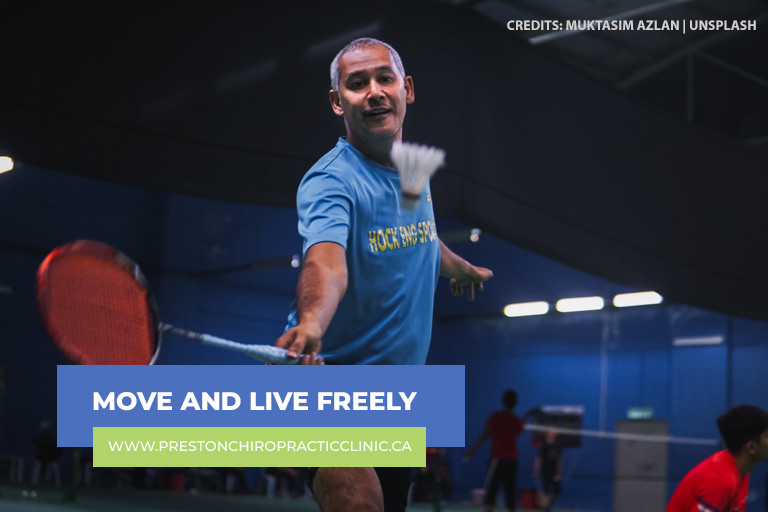
For athletes who want to stand out, having the ability to move freely is essential. Sports chiropractic care targets issues like muscle imbalances, restricted joints, and alignment concerns that might be holding you back. By making specific adjustments, gently working on soft tissues, and designing personalized exercise routines, you can improve your flexibility.
Additionally, this method works incredibly well to develop athletes to their full potential. It deals with the root causes that stop your body from moving well and working at its best. Sports chiropractic care acts like a big push for change, designed very carefully. Skilled chiropractors who know much about this understand how the spine and nervous system are connected to how well athletes can do. They make sure your body can perform at its best whenever you’re on the court or field.
Preventing Injuries and Speeding up Recovery
Injuries can be major setbacks for athletes, and naturally, you want to avoid them whenever possible. That’s where sports chiropractic care comes in with a proactive approach. It identifies vulnerabilities in your muscles and bones early on, addressing them before they escalate. By improving stability, correcting imbalances, and promoting tissue health, the chances of setbacks are significantly reduced. In case of an injury, these techniques can help speed up your recovery, ensuring you come back stronger and more determined.
Boosting Performance With a Balanced Nervous System
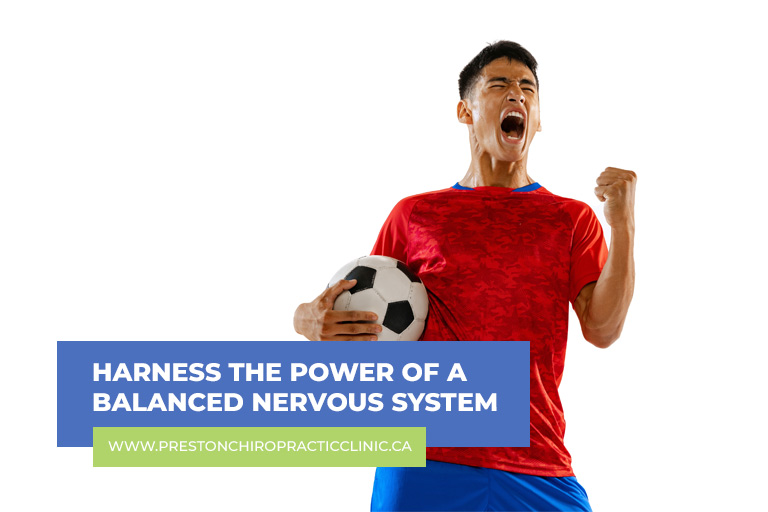
Your nervous system is the connection between your brain and body. When it’s balanced, your performance shines. Sports chiropractic care focuses on restoring and maintaining this balance. Through specific adjustments, it ensures smooth signals between your brain and muscles, leading to improved coordination, reflexes, and overall athletic ability.
Tailored Plans for Your Journey
No two athletes are the same; this is where personalized care comes in. Personalized programs are created to meet your unique objectives, strengths, and difficulties. The goal is to help you succeed in your sports endeavours and daily life. This may include specific workouts, chiropractic adjustments, nutritional advice, and lifestyle recommendations.
Get in Touch With a Chiropractor to Boost Your Performance
Chiropractic care for athletes may be the key to achieving your full potential. It can help you become more flexible, prevent injuries, manage your nervous system, and create a plan tailored to your unique needs and circumstances.
Are you ready to reach your optimal athletic abilities? Contact Preston Chiropractic & Physiotherapy Clinic so we can help you on this wonderful adventure. We offer specialized treatment to assist you in your journey and help you achieve your unique goals of breaking new ground in your chosen sports.
Reach out to us today at (519) 653-7139 to schedule a consultation with our professional chiropractors. Furthermore, if you’re looking for an all-encompassing treatment that supports your dedication to reaching peak performance and sustaining general well-being, check out our Cambridge physiotherapy services too.
BY: PrestonchroAdmin
Blog
COMMENTS: No Comments
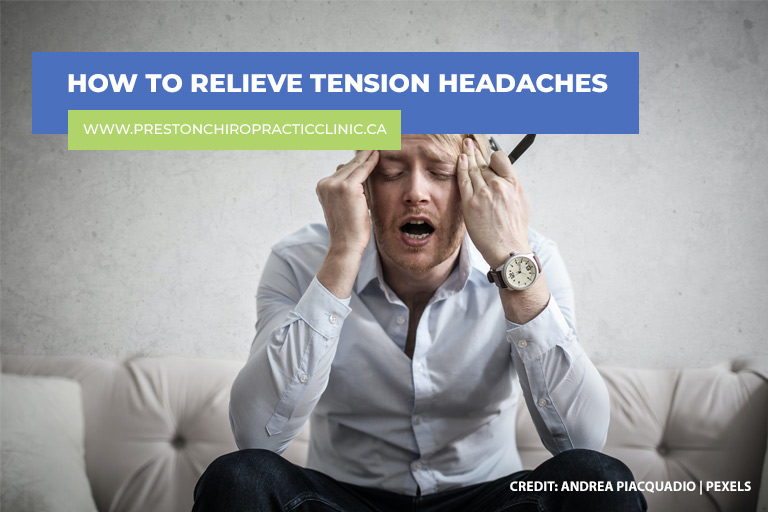 06 Sep 2023
06 Sep 2023
How to Relieve Tension Headaches
Tension headaches, widely recognized for their severe discomfort, are the most commonly occurring headache type. These headaches usually manifest during the afternoon and produce a mild to moderate pain sensation resembling pressure or a dull tightness around the head. They are triggered by strained or stressed neck, shoulder, and scalp muscles, leading to their alternate name, “stress headaches”. In adults, tension headaches are the prevailing and most frequent form of headache.
Thankfully, there are remedies for tension headaches. Successfully managing this type of headache usually involves maintaining a balance between adopting healthy habits, exploring effective non-drug options, and following the prescribed medications. Keep these strategies in mind so that the next time you ask how you get a tension headache to go away, you’ll know how to effectively handle and manage them.
What Are Tension Headaches?
A tension headache is the most common type of headache. It can manifest as a tight band around the forehead, accompanied by mild to intense pain behind the eyes and in the head and neck region.
How long do tension headaches last? The duration of these headaches can vary widely from person to person. The majority of individuals experiencing tension headaches encounter them occasionally, while some suffer from them more frequently.
Tension headaches are categorized into 2 types:
- Episodic Tension Headache
Episodic tension headaches can persist for a duration of 30 minutes to a week. Frequent episodic tension headaches occur less than 15 days per month, for at least 3 months. In some cases, these frequent episodes might progress into chronic tension headaches. Typically, this type of headache begins gradually during the afternoon.
- Chronic Tension Headache
Chronic tension headaches can last for hours and may even be continuous. These headaches occur on more than 15 days per month, lasting for at least 3 months. Compared to episodic tension headaches, chronic tension headaches are characterized by more intense pain, which might gradually improve throughout the day.
Symptoms of Tension Headaches

Common tension headaches symptoms consist of:
- A feeling of pressure or mild to moderate discomfort in the front, top, or sides of the head
- Difficulty concentrating or focusing
- Irritability
- Onset of the headache later in the day
- Difficulty sleeping
- Slight sensitivity to light or noise
- Fatigue
- Muscle soreness in the neck, shoulders, and scalp
- No nausea or vomiting with the symptoms mentioned
The pain associated with these symptoms is typically of mild to moderate intensity.
Causes of Tension Headaches
Although tension headaches are the most prevalent type of headache, what causes tension headaches remains unclear today. What’s clear is that there is no singular factor responsible for this type of headache:
- The precise cause of tension headaches continues to puzzle medical professionals and researchers. Sometimes, these headaches are associated with tense muscles in the neck and head or poor posture.
- Recent research suggests that hyperexcitable peripheral afferent neurons could be responsible for infrequent tension headaches. These specific neurons transmit sensory information from pain receptors in the body to the brain. Frequent tension-type headaches might be related to issues in your central pain processing, leading to heightened sensitivity to pain in general.
- Additionally, your genetic composition may play a role in determining your susceptibility to tension headaches.
Triggers for tension headaches encompass various factors such as stress, eye strain, dry eyes, alcohol consumption, fatigue, smoking, exposure to cold, caffeine consumption, poor posture, dehydration, lack of sleep, and skipping meals
How to Relieve Tension Headaches

Many people are well-acquainted with the discomfort brought on by tension-type headaches. Even when the pain strikes, life carries on. While medications can alleviate the pain, taking care of oneself may suffice to prevent headaches. Here are some tension headaches remedies:
- Stay Hydrated
Dehydration might be the cause of your tension headache. To address the potential link between dehydration and tension headaches, it’s important to act by increasing your water intake. Proper hydration is essential for relieving tension and promoting overall health.
- Manage Stress
Try to avoid or limit exposure to stressful situations. Incorporate daily relaxation techniques or activities to unwind. Regular practice of physical and psychological relaxation therapies can effectively mitigate the occurrence of tension headaches.
- Rest Well
It’s important to limit excessive phone and computer use to prevent eye and muscle strain. Additionally, taking frequent breaks while travelling is recommended to avoid tension build-up, promoting relaxation and reducing the risk of developing tension headaches.
- Have a Good Sleep
Establish a consistent sleep schedule, even on weekends. Engage in relaxing activities before bedtime. If you have trouble falling asleep, avoid prescription drugs with stimulants that can interfere with sleep. Addressing sleep apnea is crucial, especially if you experience morning headaches.
- Maintain Correct Posture
Poor posture can lead to tension headaches by causing tension in the upper back, neck, and shoulders. Correct posture and ergonomic adjustments before engaging in other activities can reduce headaches.
- Stay Active
Exercise releases chemicals that block pain signals in the brain. Choose enjoyable exercises and discuss them with your healthcare provider. Start slowly to avoid triggering headaches from excessive exertion.
- Quit Smoking
Smoking lowers blood flow to the brain due to nicotine and affects throat nerves, potentially leading to headaches. The compromised blood circulation and nerve reactions increase the likelihood of developing headache symptoms as a consequence of smoking.
- Seek Medical Help
For some individuals, sensitive trigger points at the back of the neck or in the shoulders can cause tension headaches. Injecting a local anaesthetic into these areas might relieve discomfort and prevent future headaches. There are also various medications that can help prevent tension headaches if non-drug approaches do not provide adequate relief. Consult your doctor about the best treatment options for you.
- Get Adjusted
Tension headaches can be triggered by various factors, including stress, whiplash, anxiety, depression, and activities causing muscle tension in the head, scalp, and neck. Individuals experiencing these headaches may feel muscle tightness in these areas. Chiropractors can identify tension headaches based on symptoms such as light sensitivity, visual disturbances, limited neck movement, and tense neck muscles. Through manual cervical adjustments, they can regulate peripheral nerve function and relieve the triggers that can cause headaches.
Tension headaches extend beyond being a mere health issue. They significantly impact your mental, emotional, social, and financial well-being. Don’t let them disrupt your daily life. Consider seeking help from a chiropractor in Cambridge at Preston Chiropractic & Physiotherapy Clinic, where therapeutic exercises are available to address your needs. Schedule an appointment today to get the treatment you need. Call us at (519) 653-7139!
BY: PrestonchroAdmin
Blog
COMMENTS: No Comments
 24 Jul 2023
24 Jul 2023
How Physiotherapy Enhances Musculoskeletal Function
Musculoskeletal disorders, whether it is pain in your joints, muscles, tendons, or ligaments, can cause uncomfortable experiences at some point in our lives.
Various factors can contribute to musculoskeletal pain—overuse of a specific body part, injury during exercise, and disease. However, the recommended treatment for each musculoskeletal disorder is specific and unique. Physiotherapy plays a significant role in your treatment and recovery.
What Is Physiotherapy for Musculoskeletal Problems

Physiotherapy is a simple yet powerful tool for treating various health conditions, including musculoskeletal disorders. While many people think that it consists of mainly manual therapy, exercises, and repetitive movements, this field is constantly evolving to embrace different branches of medicine.
Musculoskeletal physiotherapy is a specialized physical therapy procedure for patients struggling with musculoskeletal conditions. It strengthens affected areas, alleviates tension, and improves your biometrics to boost mobility and function.
The treatment addresses the factors that impact your movement—how your muscles and joints work together. An injury in your feet, ankles, legs, arms, hands, or shoulders, can have a significant impact on your life as it makes movements painful and difficult.
Among musculoskeletal injuries treated by physiotherapy:
|
|
What Is Musculoskeletal Injury?
Musculoskeletal injury is the most common type of human injury. It refers to the damage to the muscular or skeletal system due to strenuous or repetitive activities that cause impairment to the bones, muscles, joints, tendons, ligaments, and other soft tissues. Other causes include postural strain and prolonged immobilization. Poor body mechanics and changes in posture can potentially result in spinal alignment and muscle shortening, causing pain and misuse of muscles.
Symptoms of musculoskeletal injury:
- Aching and stiffness
- Fatigue
- Poor sleep quality
- Pain that worsens with movement
- Muscle twitching
- Burning sensation in the muscles
The pain associated with the musculoskeletal injury can be acute (sudden and severe) or chronic (long-lasting). A person with musculoskeletal injury may experience localized pain or pain in the entire body.
How Does Physiotherapy Work
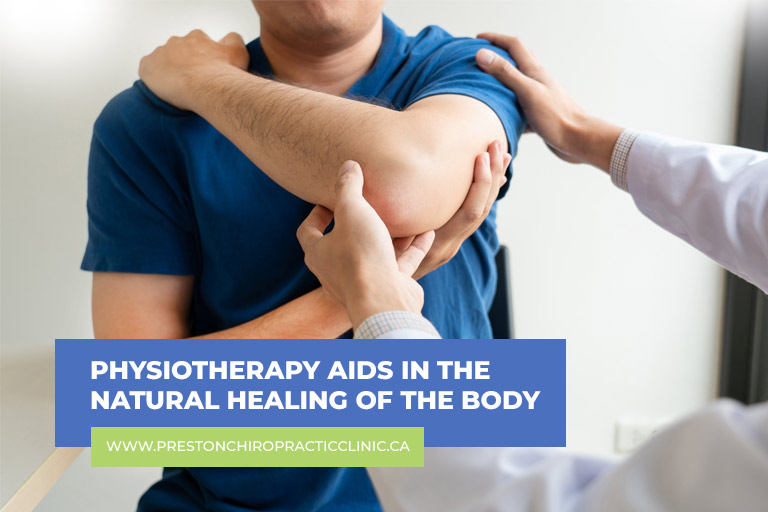
Physiotherapy is often used to assess, treat, and manage new and longstanding conditions, as well as prevent the reoccurrence of injuries and promote overall health and well-being. A registered physiotherapist will help restore and maintain your physical well-being and strength by improving your balance, flexibility, fitness, and range of motion.
To help achieve your goals, a physiotherapist will work with you through awareness, education, exercise, and personalized treatment plan and techniques. Its ‘whole-body’ approach to physiotherapy is ideal for patients of all ages and conditions.
Understanding Physiotherapy Techniques
Physiotherapists use different treatment techniques to rebuild and improve your strength and mobility. These include:
- Manual Therapy
It involves the use of hands to manipulate, mobilize, and massage body tissues to help:
- Ease pain, tension, and stiffness
- Boost blood circulation
- Improve range of movement and flexibility
- Drain fluid efficiently in specific parts of the body
- Promote relaxation
Manual therapy does not only treat musculoskeletal problems but also a range of health issues that do not affect the bones, muscles, and joints. For instance, incorporating massage therapy helps reduce anxiety levels and boost sleep quality, improving the quality of life for patients with serious health conditions. People with certain lung conditions can also benefit from manual techniques.
- Education
Physiotherapists are an excellent source of education and advice, particularly about exercise, diet, and proper postural habits. They can also provide you with helpful insights that you can integrate into your daily activities to reduce the risk of pain and injury.
- Movement and Exercise
Physiotherapists may prescribe exercises designed to boost your mobility and function. These exercises can help manage pain in the long term and lower the reoccurrence of injury.
The Role of Physiotherapy in Musculoskeletal Disorders
With regular treatment sessions, musculoskeletal physiotherapy aids in your quick recovery and builds coping mechanisms to prevent undesirable complications.
- Strengthen Affected Body Parts
Weak muscles inflict more pressure on the surrounding soft tissues and joints. Injured body parts can be serious and require longer recovery, emphasizing the need for musculoskeletal physiotherapy.
Engaging in physiotherapy-guided exercises to strengthen specific weak areas is an essential step for recovery. These exercises are designed to boost function, movement, and flexibility, lower the risk of future injury, and prevent muscle atrophy due to prolonged periods of immobility after surgery or rest.
Physiotherapists are trained and knowledgeable on various body parts and exercise variations that improve muscle strength in a safe and effective way. Physiotherapy exercises are beneficial for people struggling with disabilities or mobility issues.
- Alleviates Tension
Muscle fibres contract and relax, which enables you to make movements. However, there are various factors that contribute to muscle contraction and tension, resulting in pain and discomfort in different parts of the body.
Physiotherapy treatments help the body cope with muscle tension in a number of ways. The most common form of physiotherapy used is massage therapy, which integrates manual therapy techniques to relieve pressure. This boosts blood flow to the affected areas, allowing muscles to move more freely.
Another method used as an alternative to massage therapy to ease muscle tension and pain is chiropractic treatment. This non-invasive and drug-free approach to musculoskeletal disorders helps restore proper spine, joint, and muscle functions. The chiropractor uses spinal adjustment techniques to stimulate the body’s natural healing abilities to reduce pain, improve joint mobility, and promote overall health and well-being.
- Improve Biomechanics
Education and awareness play a vital role in physiotherapy treatment. In most cases, chronic musculoskeletal disorders are a result of improper movement or poor posture. This happens when athletes fail to use the proper movement techniques, increasing the risk of injury. Additionally, individuals with back issues who do not practice good posture may put unnecessary stress on their spine.
With the help of a well-trained and experienced physiotherapist, you can correct these problems and improve your biomechanics. Also, regular exercise can help correct imbalances in the body.
How to Prepare for Your Musculoskeletal Physiotherapy Appointment
Whether or not you got a physiotherapy referral from your physician, you must have all information your physiotherapists might need. Before coming to your appointment, be sure to prepare the following:
- List of medications you are currently taking
- An overview of your symptoms—when they occur and pain intensity
- Make sure to wear loose, and easily-removable clothing
- Health goals that you want to prioritize in our treatment
Musculoskeletal Physiotherapy: Final Thoughts
Physiotherapy is a safe and effective treatment for different musculoskeletal problems. If you are struggling with pain and discomfort in your musculoskeletal system, consult a physiotherapist ASAP. Musculoskeletal physiotherapy reduces pain and boosts your quality of life, helping you resume your normal activities.
Get the Relief You Have Been Waiting For!
If you are looking for a trusted Cambridge physiotherapy clinic, count on Preston Chiropractic and Physiotherapy Clinic. Our team of healthcare professionals uses specialized techniques to treat various musculoskeletal problems.
Give us a call today at (519) 653-7139 to book a consultation. Our staff will be happy to answer all your queries. Visit us and discover the amazing benefits of physiotherapy!
BY: PrestonchroAdmin
Blog
COMMENTS: No Comments
 27 Jun 2023
27 Jun 2023
Understanding the Science of Ergonomics and Its Importance
Many do not realize that daily interaction with various environments and technology can affect our well-being and performance.
Also known as human factors engineering, ergonomics is a relatively new branch of science that studies our interaction with the environment. It improves how we interact and improve the design of our workspaces, products, and environments. Not only does it help meet our physical needs and limitations, but it also boosts productivity and reduces the risk of work-related injuries.
Effects of Poor Ergonomics
Ergonomic hazards often result in muscle strains and fatigue. Poorly designed workstations cause employees to contort their bodies or perform awkward movements, which may result in an injury. Poor posture can also result in neck and back strain.
Health professionals claim that stress due to poor posture can increase the risk of back pain that causes joint and muscle pain. Over time, it can result in various musculoskeletal injuries.
The Science Behind Ergonomics
The study of ergonomics can help us understand the potential restrictions and responses to our environment. It uses various data and techniques in well-established disciplines, including anthropometry, biomechanics, applied psychology, environmental physics, and social psychology.
Considering the constant advancements and developments in human factors and technology, ergonomics improves the design of today’s furniture, tools, and training to prevent stress and injury.
Due to the diverse nature of ergonomics, there is no singular approach to ergonomics design. Each discipline within ergonomics follows its own set of guidelines and produces unique outcomes when designing products or procedures. Failing to adhere to these guidelines can result in significant costs and potential delays if not executed correctly.
There are 5 main components of ergonomics:
- Comfort
- Safety
- Ease of Use
- Performance/Productivity
- Aesthetics
These are critical in the prevention of potential occupational injuries, no matter what work you have.
Benefits of Ergonomics
 You can never underestimate the importance of ergonomics. It has plenty of benefits to offer to individuals, organizations, and society as a whole.
You can never underestimate the importance of ergonomics. It has plenty of benefits to offer to individuals, organizations, and society as a whole.
- Health Benefits
Ergonomic workplaces offer improved health. Its health benefits start with the cardiovascular system and spread to other vital organs. It not only boosts health but also reduces work-related injuries caused by overexertion, repetitive movements, and strains.
Additionally, ergonomic-designed workstations enable employees to adjust their desks, with chairs, and other components of their workstation to fit their height, which reduces body tension. Working in a neutral position also prevents eye, neck, and back strains, as well as better blood flow in the legs.
- Comfort and Safety
Ergonomics optimizes workplace, tools, and equipment designs to minimize body strains and fatigue, improving overall comfort and safety.
Also, ergonomically-designed desks, chairs and furniture promote better posture, which helps reduce the risk of musculoskeletal disorders, such as back pain. Providing an ergonomic workplace helps ensure healthy and productive employees.
- Boost Employee Satisfaction
Incorporating an ergonomic culture promotes a positive work environment for employees. Employees are found to be happy and satisfied working in organizations that lean into the ergonomics culture. As a result, employees feel better physically and mentally.
- Improve Quality of Work
Ergonomic workspaces improve employee well-being, which contributes to a better quality of work. Ergonomically designed workstations help boost job performance and enable employees to reach and use devices and tools easily and safely. This eliminates pain, stress, and other health problems that affect the health of the worker.
Ergonomics in Different Environments
 Ergonomics impact different environments, addressing the different requirements and challenges of each setting and enhancing safety, comfort, and efficiency.
Ergonomics impact different environments, addressing the different requirements and challenges of each setting and enhancing safety, comfort, and efficiency.
Let us look into the applications of ergonomics in various environments and highlight their specific considerations and interventions that support healthy working and living conditions. This can help you understand that it can be tailored to a specific setting so you can unlock its many benefits.
Workplace Ergonomics
- Office Ergonomics
This workplace ergonomics focuses on ergonomically-designed desks, chairs, and computer setups to promote proper body posture and reduce body strains and injuries. Ergonomic chairs and desks, as well as proper lighting and monitor positioning, are key factors in providing employees with a comfortable and productive office environment.
- Industrial Ergonomics
Industrial ergonomics focuses on the different challenges of physically demanding jobs. Prolonged standing or sitting, repetitive motions, and heavy lifting can put you at risk of musculoskeletal injuries. However, industrial ergonomic interventions can help minimize work-related injuries and boost workplace safety and efficiency.
- Healthcare Ergonomics
People working in the healthcare industry are prone to various musculoskeletal problems due to the physical demands of their job, which involves lifting and transferring patients. Healthcare professionals often perform repetitive tasks and work in awkward positions. Healthcare ergonomics helps reduce physical strain and injuries, improving patient care with better patient-handling equipment, workstations, and work process.
- Transportation Ergonomics
This type of ergonomic application focuses on devising vehicles, workstations, and control interfaces to enhance the comfort, safety, and performance of drivers and operators. Transportation ergonomics considers important factors, control placement, seat ergonomics, and visibility to boost reaction times, reduce fatigue, and promote overall road safety.
- Home Ergonomics
Ergonomics does not only apply in workspaces—it also extends to our homes. Using ergonomically-designed furniture and organizing spaces can help reduce clutter and optimize movement. Also, proper lighting and ventilation are also crucial for creating a healthy and comfortable living space.
Implementing Ergonomics
To enjoy its benefits, you must implement the practices and principles of ergonomics effectively.
- Ergonomic Assessments
An ergonomic assessment is an effective way to determine potential risks and areas for improvement. The process often involves evaluating workstations, processes, and tasks, as well as obtaining employee feedback to identify challenges and come up with tailored solutions.
- Ergonomic Design and Equipment Considerations
The application of the design principles of ergonomics is crucial in creating workspaces, products, and equipment to match the physical and cognitive capabilities of the user. That is why employers and individuals must take into consideration human factors when choosing the types of equipment to ensure a safe and comfortable experience.
- Training and Education on Ergonomics
Educating and training individuals about the importance and proper practices of ergonomics helps raise awareness and promote good habits to empower them to make better choices and improve their work and living environments.
- Incorporating Ergonomics into Workplace Policies and Practices
Ergonomics should be integrated into the policies, safety procedures and programs of organizations. Companies should establish ergonomic guidelines, encourage a culture of proactive ergonomics, and provide resources for ergonomic enhancements within the workplace.
How Massage Therapy Can Relieve Ergonomic-Related Issues
If you are struggling with the effects caused by poor ergonomics, massage therapy can bring relief. It targets specific muscle groups to ease and release tension and boost blood flow. Regular massage therapy promotes relaxation and proper posture, improving overall health and well-being.
Looking for a relaxing, healing, and therapeutically effective massage therapy in Cambridge, turn to Preston Chiropractic and Physiotherapy Clinic. Our team of registered massage therapists is trained to address various health conditions, including musculoskeletal issues.
Give us a call today at (519) 653-7139 to book an appointment. You can also send us a message through our contact form to learn more about our physiotherapy services in Cambridge.
BY: PrestonchroAdmin
Blog
COMMENTS: No Comments
 29 May 2023
29 May 2023
How Chiropractic Care Can Improve Athletic Performance and Prevent Injuries
For many athletes, maximizing performance and preventing injuries are top priorities. While proper training and nutrition are crucial components of achieving these goals, chiropractic care is another powerful tool that can improve athletic performance and reduce the risk of injury. In this article, we’ll explore how chiropractic care works and how it can benefit athletes of all levels.
What Is Chiropractic Care?
Chiropractic care is a form of healthcare that focuses on the relationship between the spine and the nervous system.
Chiropractors use spinal adjustments and other techniques to help relieve pain, restore mobility, and improve overall health and wellness.
Chiropractic care is often used to treat conditions such as back pain, neck pain, headaches, and joint pain, but it can also be used to improve athletic performance and prevent injuries.
Benefits of Chiropractic Care for Athletes

Many people wonder if chiropractic care is good for athletes. The answer is yes! Chiropractic care can improve athletic performance in several ways. Here are some of the most significant benefits:
Improved Range of Motion
Athletes who have a limited range of motion are more prone to injury and may not be able to perform to their full potential. Chiropractic adjustments can help improve joint mobility and increase range of motion, which can help athletes move more freely and perform better.
Increased Strength
Chiropractic care can also help increase strength. When the spine is properly aligned, the body can function more efficiently, allowing athletes to generate more power and strength. Additionally, chiropractors can provide exercises and stretches to help improve strength and flexibility.
Reduced Pain and Inflammation
Pain and inflammation can interfere with athletic performance and slow down recovery from injuries. Chiropractic care can help reduce pain and inflammation by addressing the underlying issues that cause them. Spinal adjustments, massage, and other techniques can be used to relieve pain and promote healing.
Improved Coordination and Balance
Coordination and balance are essential for many sports, such as gymnastics, figure skating, and martial arts. Chiropractic care can help improve coordination and balance by addressing any misalignments in the spine that can affect the body’s ability to move efficiently.
Faster Recovery from Injuries
Injuries can be a major setback for athletes, both physically and mentally. Chiropractic care can help speed up the recovery process by promoting healing and reducing pain and inflammation. Chiropractors can also provide exercises and stretches to help athletes regain strength and mobility after an injury.
How Chiropractic Care Can Prevent Injuries

In addition to improving athletic performance, chiropractic care can also help prevent injuries.
Identifying and Addressing Imbalances
Chiropractic care can identify imbalances in the body that can lead to injuries. For example, if an athlete has one leg that is shorter than the other, it can put more stress on the hips, knees, and ankles, leading to injuries over time. Chiropractors can use spinal adjustments and other techniques to address these imbalances and reduce the risk of injury.
Improving Posture
Poor posture can lead to a variety of problems, including back pain, neck pain, and headaches. It can also affect athletic performance by reducing the range of motion and strength. A chiropractor in Cambridge can help athletes improve their posture by identifying any misalignments in the spine and providing exercises and stretches to correct them.
Providing Injury Prevention Strategies
Chiropractors provide athletes with strategies to prevent injuries. This may include exercises and stretches to improve flexibility and strength, as well as tips on proper nutrition and hydration.
An experienced chiropractor can also provide advice on how to avoid overuse injuries and how to recover from injuries more quickly.
Treating Injuries Early
If an athlete does experience an injury, it’s essential to seek treatment as soon as possible. Chiropractors assist with early intervention for injuries, helping to reduce pain and inflammation and promote healing. By addressing injuries early, athletes can avoid long-term damage and get back to training and competing more quickly.
How Often Should Athletes See a Chiropractor?
The frequency with which athletes should see a chiropractor can vary depending on a number of factors, including the athlete’s age, sport, training regimen, and injury history. However, in general, most athletes benefit from regular chiropractic care as part of their overall wellness routine.
For athletes who are not currently experiencing pain or injury, a visit to the chiropractor once a month or once every few months can help maintain proper spinal alignment, reduce the risk of injury, and promote optimal nerve function. This can be particularly important for athletes who engage in repetitive motions or sports that stress the spine and joints.
For athletes who are recovering from an injury, the frequency of visits to the chiropractor may be higher. In some cases, athletes may need to see a chiropractor multiple times a week to address acute pain and inflammation and promote faster healing. As the injury improves, the frequency of visits may decrease.
Ultimately, the frequency of visits to the chiropractor will depend on the athlete’s individual needs and goals. A qualified chiropractor can work with the athlete to develop a customized treatment plan that considers their unique circumstances and helps them achieve their desired outcomes.
It’s important to note that while regular chiropractic care can be a valuable tool for athletes, it’s not a substitute for other aspects of good health, such as proper nutrition, hydration, and sleep.
Athletes should strive to maintain a balanced and holistic approach to their overall wellness, which may include a combination of chiropractic care, massage therapy, physical therapy, and other forms of treatment as needed.
Wrapping Up
Chiropractic care can be an incredibly effective tool for athletes looking to improve their performance and prevent injuries. By promoting proper spinal alignment, improving nerve function, and addressing imbalances in the body, chiropractors can help athletes achieve their goals and maintain their overall health and wellness.
At Preston Chiropractic & Physiotherapy Clinic, we specialize in working with athletes and we are committed to providing the highest level of care. Contact us today at (519) 653-7139 to book an appointment.
BY: PrestonchroAdmin
Blog
COMMENTS: No Comments
 28 Apr 2023
28 Apr 2023
Why You Should Consider Chiropractic Treatment
At some point in their lives, everyone is bound to experience pain, regardless of how healthy their body may seem. When it does occur, the discomfort may persist for a few days, and although it is typically minor, it can be relieved with over-the-counter pain relief medication. Unfortunately, pain can also be severe enough to hinder daily activities and can have significant mental and emotional consequences.
Whether you have a chronic condition that causes pain, such as arthritis, experience a sudden back injury, or undergo surgery such as knee replacement, chiropractic care is a non-invasive and gentle therapy that can make a substantial difference. While your chiropractor primarily treats your musculoskeletal and nervous systems, the benefits of treatment extend to your overall health.
What Is Chiropractic Treatment?
A chiropractic treatment is a form of therapy provided by a licensed chiropractor that involves the manipulation of joints in the body using either their hands or specialized instruments. Also known as spinal or joint manipulation, this therapeutic technique can help alleviate pain caused by various conditions that affect the bones, joints, cartilage, muscles, and connective tissue in the body, improve physical alignment, and enhance bodily function. It is often used as a complementary treatment option to traditional medical care.
What Is the Main Focus of Chiropractic Care?
The main focus of chiropractic care is to diagnose and treat conditions related to the musculoskeletal and nervous systems, with a primary emphasis on the spine. Chiropractors aim to identify and address the underlying causes of pain and discomfort, rather than simply treating the symptoms. By performing spinal and joint manipulations, chiropractors can help alleviate pain, improve bodily function, and enhance overall health and well-being. Additionally, chiropractic care may involve providing patients with exercise and lifestyle recommendations to help them achieve optimal health.
Why Would You Need a Chiropractor?

If you’re seeking a safe and effective method of pain relief, chiropractic treatment may be an option worth considering. Unlike over-the-counter pain medications, chiropractic care can provide long-lasting relief from discomfort for those living with conditions like arthritis, back pain, carpal tunnel syndrome, fibromyalgia, headaches, neck pain, and shoulder pain. By performing spinal manipulations, chiropractors facilitate the body’s natural healing process.
Here are a few reasons why you may want to consider chiropractic treatment:
- It treats the pain at its source
While pain medication may temporarily alleviate discomfort, it does not address the underlying issue causing the pain. As soon as the medication’s effects wear off, the pain is likely to return.
Chiropractic care, on the other hand, aims to treat the root cause of the pain, providing long-term relief. By manipulating the joints and spine, chiropractors can restore proper alignment and functionality, allowing the body to heal itself naturally. Additionally, chiropractic care may involve recommendations for exercise and lifestyle modifications that can help prevent the pain from recurring in the future. This approach offers a more comprehensive and sustainable solution to pain management.
- It reduces reliance on medication
Individuals who experience chronic pain are frequently prescribed opioid pain relievers to help alleviate their discomfort. Nevertheless, receiving chiropractic treatment may potentially decrease their reliance on these pain relievers.
A significant study conducted in 2020 compared the number of opioid pain reliever prescriptions filled by adults who sought treatment for spinal pain from either just a doctor or both a chiropractor and a doctor. The research revealed that individuals who received chiropractic treatment were less likely to have their opioid prescriptions filled for pain management when compared to those who only sought treatment from their doctor.
- It’s cost-effective
Pain medication is not only associated with potential health risks, but it can also be expensive in the long run. Even with insurance coverage, the cost of using painkillers can accumulate over time. Fortunately, chiropractic care can offer an affordable approach to pain management.
Chiropractors can provide patients with various at-home techniques that can help improve mobility and manage pain without the use of medication. By incorporating these techniques into their daily routine, patients can potentially reduce their reliance on pain medication, leading to improved overall health and reduced healthcare costs.
- It’s consistent and sustainable
As the body begins to recover through chiropractic treatment, the intensity and frequency of the therapy may decrease over time. This is because the goal of chiropractic care is to address the underlying cause of pain and help the body heal itself naturally. This is a more sustainable and healthy approach to pain management compared to relying solely on medication, which may lead to dependence and increased dosages over time.
- It can be used preventatively
The combination of spinal manipulation, lifestyle changes, stretching, and exercise can help maintain proper spinal alignment and function, improving the body’s ability to heal and prevent future problems. By taking a proactive approach to spinal health, individuals can potentially reduce their risk of developing conditions, such as herniated lumbar discs and sciatica, and maintain better overall health and well-being.
Chiropractic Goes Beyond Pain Treatment

There are many compelling reasons to consider chiropractic care, including its ability to provide a range of natural, drug-free treatments with numerous benefits. While some people may be concerned about potential chiropractic adjustment side effects, studies have shown that serious complications are extremely rare. In fact, chiropractic care doesn’t just address pain, but can also significantly improve your overall quality of life.
In addition to pain relief, chiropractic care can effectively treat a variety of other health conditions:
- Fatigue
When you experience pain, your body may feel exhausted and fatigued. Chiropractic care can help to enhance the body’s natural ability to fight pain, which can lead to patients feeling re-energized after treatment. As a result, many patients report feeling invigorated and revitalized after receiving chiropractic care.
- Insomnia
Individuals with chronic pain often struggle to achieve restful sleep, which can lead to a host of additional health concerns. Chiropractic care can help individuals achieve more restful and restorative sleep, which can reduce the risk of other health issues associated with sleep deprivation.
- Stress
Stress is a common issue that affects both the mind and body. While stress itself may not directly cause pain, it can still lead to physical symptoms. Chiropractic care can help eliminate stress and improve overall well-being. In many ways, chiropractic treatment can be compared to a spa experience that leaves patients feeling rejuvenated and energized not just physically, but also mentally and emotionally.
Can You Go to a Chiropractor for No Reason?
Yes, you can go to a chiropractor even if you don’t have any specific health issues or pain. Chiropractors can provide preventative care to help maintain the proper alignment of the spine and nervous system. Some people also visit chiropractors for stress relief or to improve their athletic performance. The chiropractic benefits for adults are plenty, and it’s important to discuss your goals and concerns with the chiropractor to determine if chiropractic care is right for you.
If you want to pamper yourself, try chiropractic therapy instead. Regular chiropractic care can help you feel calm, refreshed, and healthy.
If you’re looking for natural healthcare options to alleviate pain and enhance your overall well-being, schedule an appointment with a chiropractor in Cambridge at Preston Chiropractic Clinic by calling us at (519) 653-7139.
BY: PrestonchroAdmin
Blog
COMMENTS: No Comments
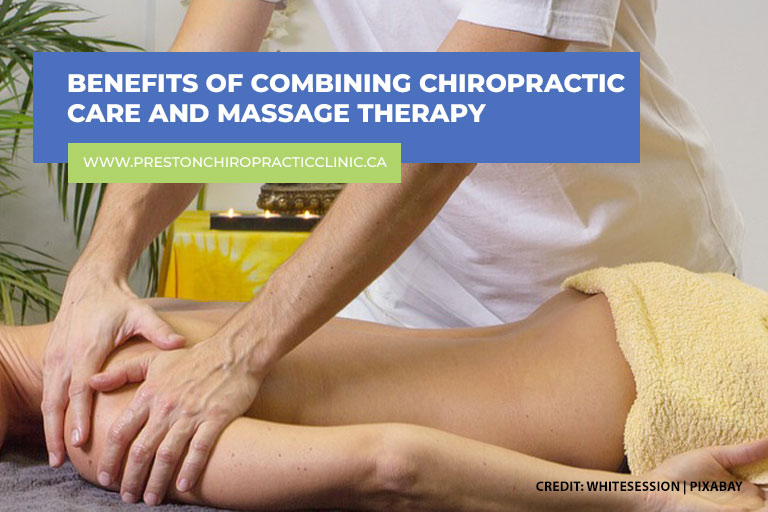 24 Mar 2023
24 Mar 2023
Benefits of Combining Chiropractic Care and Massage Therapy
Are you struggling with chronic pain? Do you feel your body is out of balance? Combined chiropractic care and massage therapy can help. You can experience improved mobility, reduced tension, and enhanced overall well-being when both therapies are used together. Keep reading to discover the benefits of this powerful duo.
Benefits of Chiropractic Care
Chiropractic care is a treatment used to help maintain the alignment of the spine and other joints.
By manipulating and realigning the spine, chiropractors relieve pressure on the vertebrae, discs, and nerves, improving mobility, reducing pain, and alleviating symptoms of many musculoskeletal conditions.
Additionally, chiropractic care can improve circulation by loosening tight muscles that cause stagnation and enabling increased delivery of oxygen-rich blood to soft tissue areas throughout the body.
Several different specific techniques are often used during an adjustment session to enhance its effectiveness. Manual manipulation of joints as well as “mobilizations” or gentle stretches that are done with a partner are common procedures during this type of therapy.
Depending on your condition, your massage therapist in Cambridge may also use specific modalities such as electric muscle stimulation, ultrasound therapy, or trigger retraining techniques on certain body parts. The goal is always to restore balance with gentle movements that help increase mobility.
In addition to tension relief through joint realignment, many patients report discomfort from pinched nerves caused by excessive strain in other areas, such as the neck or arm, due to poor posture over time.
Various treatments combined with regular chiropractic care help restore normal movement patterns, reducing pain associated with muscular imbalances created by poor lifestyle choices.
Benefits of Massage Therapy
Massage therapy is an ancient practice that has been around for centuries. It is widely accepted as a complementary and alternative medical (CAM) treatment for various physical and emotional benefits.
Typically, massage therapy treatments involve the manipulation of the body’s soft tissue, including muscles, connective tissue, tendons, ligaments, and skin. Massage therapy can help treat various conditions, from musculoskeletal issues such as lower back pain to emotional issues such as stress and anxiety.
When combined with chiropractic care, massage therapy can provide additional benefits by addressing muscle soreness, tightness, and tension — common side effects of chiropractic adjustments.
How Chiropractic Care and Massage Therapy Work Together

Chiropractic care focuses on the spine and surrounding structures, while massage therapy works to relax muscles, improve circulation, and increase mobility.
When used together, these treatments create an environment that promotes healing from injury or illness and offers pain relief. In many cases combining chiropractic care and massage therapy can produce enhanced results in far fewer visits than if each treatment was used alone.
Below are some of the most significant benefits of combining massage therapy and chiropractic care:
Pain Relief
Pain relief is the most commonly sought-after benefit of chiropractic and massage therapy. When coupled together, chiropractic care and massage therapy can provide effective relief without relying on medication.
Massage helps to relax your muscles and improve circulation, while spinal manipulation reduces misalignments to improve your body’s natural ability to heal. Together, they help alleviate back pain, neck pain, headaches, fatigue, and stress associated with the tension of the muscles.
The combination of chiropractic care and massage therapy also helps to alleviate long-term chronic conditions such as sciatica or a herniated disc by reducing the tension on stressed nerves in the spine. In addition to physical benefits, these treatments can also give an emotional boost since they reduce stress and discomfort.
Improved Mobility
Combining chiropractic care and massage therapy provides the opportunity to experience a range of benefits for improved mobility. Chiropractic massage and adjustment help ensure spinal alignment and support, while massage therapy stretches, relaxes, and strengthens muscles around the body.
Both treatments improve the overall function of soft tissues so that aches and pains can be alleviated while promoting better flexibility and strength that results in optimal performance in activities throughout your day. Enhanced coordination, balance, posture, and stability can also be seen when chiropractic care and massage therapy are used together to promote improved mobility.
Improved Posture
Combining chiropractic adjustments with massage therapy can help improve your body’s alignment and posture. Chiropractic adjustments restore proper movement to the spine, while massage techniques can help relax the muscles and promote flexibility. This combination can help reposition various parts of the musculoskeletal system and balance them out.
Improved spinal alignment helps keep your body upright with a straight spine and proper head tilt. In addition to joint-specific changes, this process considers the entire body making corrections using integrated stretches, muscle release techniques, joint mobilizations, and other treatment approaches that encourage improved movement throughout your entire body.
Along with improved posture and alignment, this combined approach can help correct poor posture habits caused by sitting for long periods or hunching over a computer screen all day. The resulting back pain and any associated muscular tension from tightness or stress will often decrease.
Ultimately, Therapeutic Massage can provide a comprehensive approach that enables you to enhance mobility while encouraging the development of proper posture habits at home.
Invest in a Chiropractor in Cambridge
Overall, experimenting with chiropractic care and massage therapy together may benefit those suffering from a range of physical ailments.
Each discipline offers unique benefits to patients, and combining the two can effectively treat existing pain. That being said, finding an experienced professional is the first step you’ll want to take when considering chiropractic care and/or massage therapy.
At Preston Chiropractic Clinic, we offer comprehensive chiropractic services designed to help you feel your best. Call us today at (519) 653-7139 to schedule an appointment.
BY: PrestonchroAdmin
Blog
COMMENTS: No Comments

